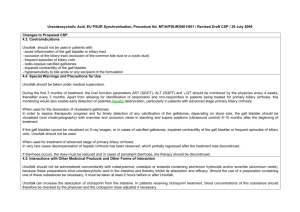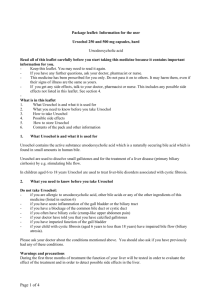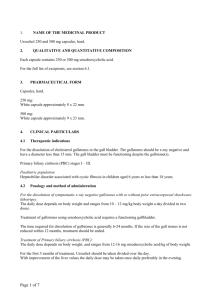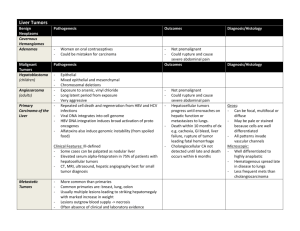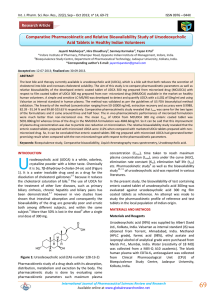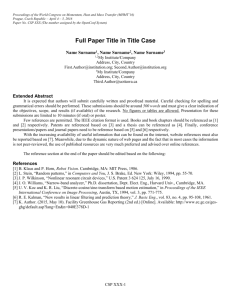P-RMS
advertisement
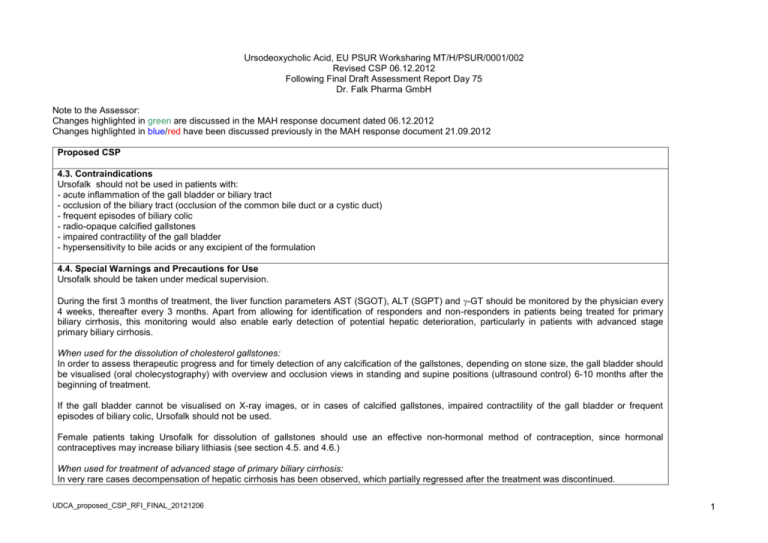
Ursodeoxycholic Acid, EU PSUR Worksharing MT/H/PSUR/0001/002 Revised CSP 06.12.2012 Following Final Draft Assessment Report Day 75 Dr. Falk Pharma GmbH Note to the Assessor: Changes highlighted in green are discussed in the MAH response document dated 06.12.2012 Changes highlighted in blue/red have been discussed previously in the MAH response document 21.09.2012 Proposed CSP 4.3. Contraindications Ursofalk should not be used in patients with: - acute inflammation of the gall bladder or biliary tract - occlusion of the biliary tract (occlusion of the common bile duct or a cystic duct) - frequent episodes of biliary colic - radio-opaque calcified gallstones - impaired contractility of the gall bladder - hypersensitivity to bile acids or any excipient of the formulation 4.4. Special Warnings and Precautions for Use Ursofalk should be taken under medical supervision. During the first 3 months of treatment, the liver function parameters AST (SGOT), ALT (SGPT) and -GT should be monitored by the physician every 4 weeks, thereafter every 3 months. Apart from allowing for identification of responders and non-responders in patients being treated for primary biliary cirrhosis, this monitoring would also enable early detection of potential hepatic deterioration, particularly in patients with advanced stage primary biliary cirrhosis. When used for the dissolution of cholesterol gallstones: In order to assess therapeutic progress and for timely detection of any calcification of the gallstones, depending on stone size, the gall bladder should be visualised (oral cholecystography) with overview and occlusion views in standing and supine positions (ultrasound control) 6-10 months after the beginning of treatment. If the gall bladder cannot be visualised on X-ray images, or in cases of calcified gallstones, impaired contractility of the gall bladder or frequent episodes of biliary colic, Ursofalk should not be used. Female patients taking Ursofalk for dissolution of gallstones should use an effective non-hormonal method of contraception, since hormonal contraceptives may increase biliary lithiasis (see section 4.5. and 4.6.) When used for treatment of advanced stage of primary biliary cirrhosis: In very rare cases decompensation of hepatic cirrhosis has been observed, which partially regressed after the treatment was discontinued. UDCA_proposed_CSP_RFI_FINAL_20121206 1 Proposed CSP In patients with PBC, in rare cases the clinical symptoms may worsen at the beginning of treatment, e.g. the itching may increase. In this case the dose of Ursofalk® should be reduced to one Ursofalk 250mg capsule daily and then gradually increased again as described in section 4.2. If diarrhoea occurs, the dose must be reduced and in cases of persistent diarrhoea, the therapy should be discontinued. 4.5. Interactions with Other Medicinal Products and Other Forms of Interaction Ursofalk should not be administered concomitantly with colestyramine, colestipol or antacids containing aluminium hydroxide and/or smectite (aluminium oxide), because these preparations bind ursodeoxycholic acid in the intestine and thereby inhibit its absorption and efficacy. Should the use of a preparation containing one of these substances be necessary, it must be taken at least 2 hours before or after Ursofalk. Ursofalk can increase affect the absorption of ciclosporin from the intestine. In patients receiving ciclosporin treatment, blood concentrations of this substance should therefore be checked by the physician and the ciclosporin dose adjusted if necessary. In isolated cases Ursofalk can reduce the absorption of ciprofloxacin. In a clinical study in healthy volunteers concomitant use of UDCA (500mg/day) and rosuvastatin (20mg/day) resulted in slightly elevated plasma levels of rosuvastatin. The clinical relevance of this interaction also with regard to other statins is unknown. Ursodeoxycholic acid has been shown to reduce the plasma peak concentrations (C max) and the area under the curve (AUC) of the calcium antagonist nitrendipine in healthy volunteers. Close monitoring of the outcome of concurrent use of nitrendipine and ursodeoxycholic acid is recommended. An increase of the dose of nitrendipine may be necessary. An interaction with a reduction of the therapeutic effect of dapsone was also reported. These observations together with in vitro findings could indicate a potential for ursodeoxycholic acid to induce cytochrome P450 3A enzymes. Controlled clinical trials have shown, however, that ursodeoxycholic acid does not have a relevant inductive effect on cytochrome P450 3A enzymes. Induction has, however, not been observed in a well-designed interaction study with budesonide, which is a known cytochrome P450 3A substrate. Oestrogenic hormones and blood cholesterol lowering agents such as clofibrate increase hepatic cholesterol secretion and may therefore encourage biliary lithiasis , which is a counter-effect to ursodeoxycholic acid used for dissolution of gallstones. 4.6. Fertility, Pregnancy and Lactation Animal studies did not show an influence of ursodeoxycholic acid on fertility (see section 5.3). Human data on fertility effects under following treatment with ursodeoxycholic acid are not available. There are no or limited amounts of data from the use of ursodeoxycholic acid in pregnant women. Studies in animals have shown reproductive toxicity during the early phase of gestation (see section 5.3). Ursofalk must not be used during pregnancy unless clearly necessary. Women of childbearing potential should be treated only if they are using reliable contraception; non-hormonal or low-oestrogen oral contraceptive measures are recommended. However, in patients taking Ursofalk for dissolution of gallstones, effective non -hormonal contraception should be used, UDCA_proposed_CSP_RFI_FINAL_20121206 2 Proposed CSP since hormonal oral contraceptives may increase biliary lithiasis. The possibility of a pregnancy must be excluded before beginning treatment. .It is unknown whether ursodeoxycholic acid is excreted in human milk. A risk to the newborn/infant cannot be excluded. Therefore, Ursofalk should not be taken during lactation. If treatment with Ursofalk is necessary, the infant should be weaned. According to few documented cases of breastfeeding women milk levels of Ursodeoxycholic acid are very low and probably no adverse reactions are to be expected in breastfed infants. 4.7. Effects on the Ability to Drive Ursodeoxycholic acid has no or negligible influence on the ability to drive and use machines 4.8. Undesirable Effects The evaluation of undesirable effects is based on the following frequency data: Very common ( 1/10) Common ( 1/100 to 1/10) Uncommon ( 1/1,000 to < 1/100) Rare ( 1/10,000 to < 1/1,000): Very rare / Not known (< 1/10,000 / cannot be estimated from available data) Gastrointestinal disorders: In clinical trials, reports of pasty stools or diarrhoea during ursodeoxycholic acid therapy were common. Very rarely, severe right upper abdominal pain has occurred during the treatment of primary biliary cirrhosis. Hepatobiliary disorders: During treatment with ursodeoxycholic acid, calcification of gallstones can occur in very rare cases. During therapy of the advanced stages of primary biliary cirrhosis, in very rare cases decompensation of hepatic cirrhosis has been observed, which partially regressed after the treatment was discontinued. Skin and subcutaneaous tissue disorders: Very rarely, urticaria can occur. UDCA_proposed_CSP_RFI_FINAL_20121206 3 Proposed CSP 4.9. Overdose Diarrhoea may occur in cases of overdose. In general, other symptoms of overdose are unlikely because the absorption of ursodeoxycholic acid decreases with increasing dose and therefore more is excreted with the faeces. No specific counter-measures are necessary and the consequences of diarrhoea should be treated symptomatically with restoration of fluid and electrolyte balance. Additional information on special populations: Long-term, high-dose UDCA therapy (28-30 mg/kg/day) in patients with primary sclerosing cholangitis (off-label use) was associated with higher rates of serious adverse events. UDCA_proposed_CSP_RFI_FINAL_20121206 4
